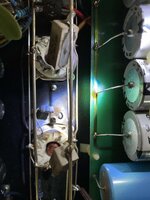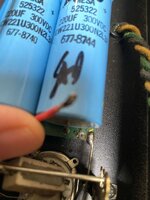MikeBoneman
New member
Hello, I accidentally blew my Bass 400. I plugged things in, warmed up at a low volume. Few minutes into first song there was a spark and burnt smell. I realized what had happened, speaker cable was not 100% pushed into my cab.
I examined and saw a blast mark around a resistor (100 ohm I believe) near the second power tube, resistor broke in half when touched. This resistor seems connected to the wire connecting to R311 which got burned off and was hanging loose. My understanding based on a little research is this is related to the heater circuit. Fuse was still intact but had burns on the glass. The board didnt look scorched anywhere else with a visual.
Based on other pics, it appears that half the caps on this were replaced with some gray ones.
I will probably need to take this to a tech but loathe to think about the potential costs! Any thoughts on what could be wrong? I can fix a resistor and probably reconnect to 311, and replace some tubes. I have access to repair and testing tools but anything beyond a little soldering is probably out of my league.
Any thoughts on the possible collateral damage (for example, could all tubes get blown by this?) or insights on what could have happened under the circumstances (like if speaker wasnt fully plugged in, would it cause power tubes to overheat and maybe short the circuit?).
I examined and saw a blast mark around a resistor (100 ohm I believe) near the second power tube, resistor broke in half when touched. This resistor seems connected to the wire connecting to R311 which got burned off and was hanging loose. My understanding based on a little research is this is related to the heater circuit. Fuse was still intact but had burns on the glass. The board didnt look scorched anywhere else with a visual.
Based on other pics, it appears that half the caps on this were replaced with some gray ones.
I will probably need to take this to a tech but loathe to think about the potential costs! Any thoughts on what could be wrong? I can fix a resistor and probably reconnect to 311, and replace some tubes. I have access to repair and testing tools but anything beyond a little soldering is probably out of my league.
Any thoughts on the possible collateral damage (for example, could all tubes get blown by this?) or insights on what could have happened under the circumstances (like if speaker wasnt fully plugged in, would it cause power tubes to overheat and maybe short the circuit?).



